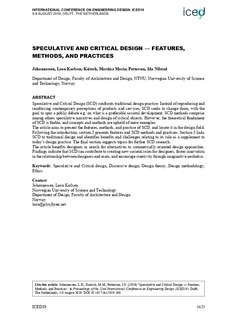| dc.contributor.author | Johannessen, Leon Karlsen | |
| dc.contributor.author | Keitsch, Martina | |
| dc.contributor.author | Pettersen, Ida Nilstad | |
| dc.date.accessioned | 2020-01-27T13:38:19Z | |
| dc.date.available | 2020-01-27T13:38:19Z | |
| dc.date.created | 2019-12-15T16:00:16Z | |
| dc.date.issued | 2019 | |
| dc.identifier.citation | Proceedings of the International Conference on Engineering Design. 2019, 1 (1), 1623-1632. | nb_NO |
| dc.identifier.issn | 2220-4334 | |
| dc.identifier.uri | http://hdl.handle.net/11250/2638109 | |
| dc.description.abstract | Speculative and Critical Design (SCD) confronts traditional design practice. Instead of reproducing and reinforcing contemporary perceptions of products and services, SCD seeks to change them, with the goal to spur a public debate e.g. on what is a preferable societal development. SCD methods comprise among others speculative narratives and design of critical objects. However, the theoretical fundament of SCD is feeble, and concepts and methods are upheld of mere examples.
The article aims to present the features, methods, and practice of SCD, and locate it in the design field. Following the introduction, section 2 presents features and SCD methods and practices. Section 3 links SCD to traditional design and identifies benefits and challenges relating to its role as a supplement to today's design practice. The final section suggests topics for further SCD research.
The article benefits designers in search for alternatives to commercially oriented design approaches. Findings indicate that SCD can contribute to creating new societal roles for designers, foster innovation in the relationship between designers and users, and encourage creativity through imaginative aesthetics. | nb_NO |
| dc.language.iso | eng | nb_NO |
| dc.publisher | Cambridge University Press (CUP) | nb_NO |
| dc.rights | Navngivelse 4.0 Internasjonal | * |
| dc.rights.uri | http://creativecommons.org/licenses/by/4.0/deed.no | * |
| dc.title | Speculative and Critical Design — Features, Methods, and Practices | nb_NO |
| dc.type | Journal article | nb_NO |
| dc.type | Peer reviewed | nb_NO |
| dc.description.version | publishedVersion | nb_NO |
| dc.source.pagenumber | 1623-1632 | nb_NO |
| dc.source.volume | 1 | nb_NO |
| dc.source.journal | Proceedings of the International Conference on Engineering Design | nb_NO |
| dc.source.issue | 1 | nb_NO |
| dc.identifier.doi | https://doi.org/10.1017/dsi.2019.168 | |
| dc.identifier.cristin | 1760897 | |
| dc.description.localcode | © The Author(s) 2019 This is an Open Access article, distributed under the terms of the Creative Commons Attribution-NonCommercial-NoDerivatives licence (http://creativecommons.org/licenses/by-nc-nd/4.0/), which permits non-commercial re-use, distribution, and reproduction in any medium, provided the original work is unaltered and is properly cited. The written permission of Cambridge University Press must be obtained for commercial re-use or in order to create a derivative work. | nb_NO |
| cristin.unitcode | 194,61,45,0 | |
| cristin.unitname | Institutt for design | |
| cristin.ispublished | true | |
| cristin.fulltext | original | |
| cristin.qualitycode | 1 | |

